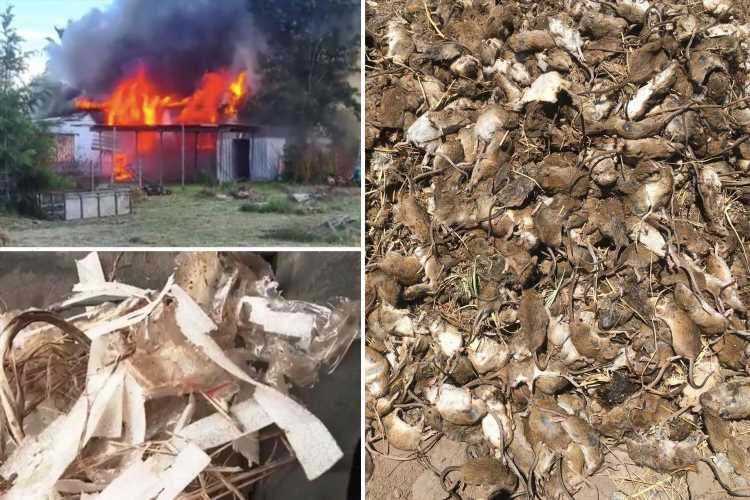THERE have been calls for Australia's mouse plague to be declared a "natural disaster" after a house was torched, cars were destroyed and crops left decimated.
Tens of millions of rampaging mice have sparked horrific outbreaks stretching 1,000km from Brisbane down to Melbourne and tormented farming communities for nearly a year.
As the Australian winter sets in, home and car owners have been forced to deal with rats and mice looking for warmer places to live.
The rodents have eaten through electrical wires which sparked a house fire in Narrabri, New South Wales, while cars have been damaged.
Some frustrated Aussies claim the plague should be considered a "natural disaster" so they can claim insurance payouts.
Mum-of-three Shirilee Jackson, 31, who lives in Mandagery, New South Wales, said a swarm of rats and mice left her car damaged beyond repair in just one night.
She told A Current Affair: "Ten grand's (£5,474) worth of damage. I've woken up at five o'clock in the morning to find the seatbelts chewed, the heater unit, flooring, head rest, and child's car seat chewed.
"It's just unreal, in a matter of 10 hours."
Mrs Jackson said she has insurance and tried to make a claim but was told she wasn't able to.
Major insurance companies in Australia have told customers that general home and contents insurance and car insurance does not protect against rats and mice unless there are other effects, such as a fire or floods.
Andrew McKenzie, a mechanic in Orange, NSW, said the damage caused by the infestation of rodents was getting worse.
"I'm now getting up to four cars a day," he said.
He said one driver he spoke to had his brakes fail at a dangerous intersection, while another motorist said her car nearly burst into flames.
Mr Mckenzie said: "The rats had built a nest under the engine cover and chewed through the fuel line and made it leak fuel everywhere.
"It was actually parked in a garage adjoining the house, so it could have been a bad situation."
APOCALYPSE MOUSE
In just three months, two mice can spark a colony of almost 400, rapidly spawning to tens of thousands, Daily Mail Australia reports.
A mouse can live for up to two or three years – and females can start reproducing at just six weeks of age.
They can give birth to ten babies every three weeks and the mum can get pregnant again the very next day.
Experts have warned "without a concerted baiting effort in the next few weeks this could easily turn into a two-year plague event".
And in a desperate bid to stop the mouse menace, the government in New South Wales has secured 5,000 litres of the toxic rodent poison bromadiolone – dubbed "napalm for mice" – which is currently banned for agriculture use in the country.
But the state has offered to provide it for free if the Australian Pesticides and Veterinary Medicines Authority approves it.
Bromadiolone kills rats and mice by preventing the blood from clotting and can be lethal from one day of eating the poison, according to the National Pesticide Information Center.
Announcing the measure as part of a $50million package to curb the outbreak, Agriculture Minister Adam Marshall said the poison would be "the equivalent of napalming mice" across the affected regions.
The mice are almost certainly descended from rodent stowaways on British convict ships nearly 250 years ago.
The common house mice (mus musculus) is thought to have only appeared in the vast country in the wake of the arrival of the British First Fleet – which carried 750 convicts to Botany Bay in 1788.
They scuttled through holds and cabins as the ships made their way to the other side of the world before the rodents then scurried onto dry land with the new settlers.
DNA sequencing tests indicate there is a "strong link" with the mice found Down Under and those seen in Western Europe, reports the US National Library of Medicine National Institutes of Health.
Source: Read Full Article








